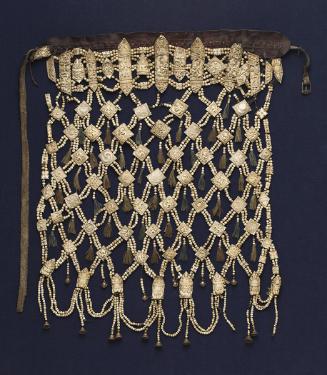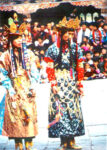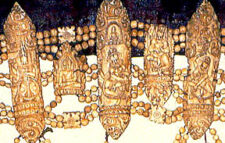
Unknown
Tibetan
Ritual Bone Apron, 17th-18th c. CE
Bone, leather, brass
34 x 28 inches
SBMA gift of Mrs. Wilbur L. Cummings Sr. in memory of her son, Wilbur L. Cummings
1954.15.2

"Dances are important in Buddhist society; they are brilliant, beautiful and emotional: full of rich meaning. They remind the followers of the”fragility of existence” and the “swift passage of time” bringing them together as a community to rededicate themselves to a life based on caring for each other.” -(Ricard)
RESEARCH PAPER
In the great Dance of the Lord of the Cemetery, Tibetan Monks wearing golden crowns and the white Ritual Bone Aprons around their waists over their colorful silken robes, chant, blow horns and dance.
Lights flicker. Incense and the smell of flowers fill the air. Kicking and waving their long bony fingers, they make an awesome spectacle as they personify the Lord of Death.
Their intention is not to frighten the spectators, but to remind them of the Buddhist promise: a morally upright person has nothing to fear from death. In Tibetan Buddhism it is believed when a person dies the mind/spirit leaves the body behind: it has just been a guesthouse in which mind and body have lived for a short time.
CULTURAL CONTEXT AND MEANING
The tradition of this Dance of Death and the use of Bone Ritual Aprons originated as part of the shamanistic rituals of the nomadic culture that first settled Tibet: the Ban Society. Their rituals blended traditions borrowed from the rich interplay of cultures that met there: Indian, Iranian, Chinese and Nepalese.
In the harsh climate of Tibet, death was common. To survive, the people formed a strict hierarchical order and lived in monasteries, which functioned like cities. They were governed by the absolute authority of the monks who were thought of as shamans, magicians as well as spiritual counselors. To ensure their part in the society, each family was required to produce one son to serve as monk whose responsibility it was to care for the family’s well-being and keep alive the memory of its ancestors.
In the 7th Century when Buddhism was introduced into this region of China, it offered the promise that life is an ongoing cycle of birth, death, and rebirth. When a person died the mind/spirit left the body behind and moves on the Path to Enlightenment: Death is simply another stage in the unending cycle of life. So by the 8th Century records confirm that the symbolic meaning of the ancient Ritual Bone Aprons, took on Buddhist meaning. It became one of the six ornaments for the costumes for the ancient Dance of Death that included a crown of skulls, armlets, anklets, bracelets, and a double line of bone beads.
According to Robert Beer in The Encyclopedia of Tibetan Symbols and Motifs, each of the bone ornaments represented one of the 6 Perfections one must attain in order to reach Enlightenment. The bone wheel on the crown represented meditation; the ash on the forehead: wisdom; the necklace: generosity; the bracelets, the armlets and anklets: morality; the bone earrings: patience; and the bone belt/apron signified the energy needed for action” (page 318). Imagining the apron swaying and hearing the unique clacking sounds of the bones as the monk moves in the dance, it is easily understood why the bone apron was assigned the perfection of “energy for action” or willpower to do what is necessary to achieve Enlightenment.
THE GENERAL FORM OF THE BONE APRON
The earliest preserved examples of Ritual Bone Aprons come from Central Tibet and date to the 14th and 15th Century. They were made of human and animal bones, leather belting, bone beads, brass bells, and string tassels.
Because of the fragile nature of the materials used for their construction, the strings, cords, and/or thongs that link the bone plaques together might easily have decayed or worn out from the friction of movement during the ritual dances. Therefore, few if any still remain perfectly intact today. On scholarly review of published examples of ritual bone aprons, it has been determined that there was no one prescribed standard for the design of these aprons. But generally the aprons are either categorized as triangular or rectangular. Beyond this broad category each is composed of different numbers and types of plaques and tiers of medallions dependent either on the artisan’s skills, the availability of materials, or on the relative importance of the ceremony in which the apron will be used.
The use of bone for ritual objects was not only employed because of its' mystical association with death, but also because there was very little wood or any other malleable material available to create ritual objects in this rugged Tibetan terrain. Also because of this forbidding environment, burial of the dead was impractical, if not altogether impossible during the long frigid winter season. The lack of wood meant that bodies could not be cremated. Hence "sky burial" was developed and is still used today. The body of the deceased is placed on the elevated pyre and after an appropriate length of time of exposure and decay; the bones are reclaimed by Cemetery yogis and turned into bowls, beads for rosaries, trumpets, drums, and Ritual Bone Aprons.
THE SBMA RITUAL BONE APRON
THE SBMA Ritual Bone Apron was given to the Museum in 1954, by Mrs. Wilbur L. Cummings Sr. in memory of her son. It was one of 25 objects including small Tibetan statues, paintings, a Tibetan trumpet, as well as 2 objects of Chinese/Thai origin. It may be inferred that Mrs. Cummings and/or her son collected Tibetan devotional art objects. The Curatorial Registration sheet states the earlier history of the bone apron as "unknown."
By comparison to others, the SBMA Bone Apron is considered “rare” (as described in the SBMA Curatorial File) because it has mostly original pieces and it is still complete and intact. Only very small parts of it have been restrung.
While unquestionably rectangular, it was constructed with more rows and plaques than most of the smaller bone aprons found in other collections: perhaps suggesting a more important use than the smaller ones.
The Conservators' evaluation for the SBMA Bone Apron indicates it is comprised mostly of animal bones because they are “more yellowish in color; while human bones being a paler shade.” The bone fragments are carefully carved into plaques and arranged in many tiers. Between each plaque are strings of round bone beads forming diamond shaped open spaces and linking to the other tiers.
First where the apron is attached to a leather waist belt there is a yoke that forms a kind of waistband holding the upper portion rigid against the hips and allowing the woven portion below to swing freely. There are 7 large plaques in this yoke; which include 5 carved dancing figures and 2 skeletons (citipati): one at each end of the row. “
… most often they dance in parallel lines, but sometimes it is evident that they are a couple -- a male and female that dance in complementary or opposite fashion, intertwined and gazing at each other.†…
Legend tells how a pair of yogis were so absorbed in their meditation inside a certain Himalayan cave, that they did not even notice when a murderous brigand cut off their heads.† Some believe that they have sworn revenge on all such marauders and will stop at nothing to protect their domain.” †(From Website www.Khandro.net )
Between these 2 skeletons, there are 5 standing or dancing deities. As one compares it to many other bone aprons, it is evident that each artisan might have chosen different deities, or figures to place in this line probably depending on the intended use of the apron.
In the SBMA Bone Apron, these five deities could represent the five wrathful female dakinis: each one of them wears only the five other ornaments of the bone costume and only when all five are used together do they represent the sixth perfection of “wisdom” over evil.
Underneath this first tier/yoke, are 8 tiers of carved bone medallions or plaques arranged in an open diamond latticework or net. The diamond shape connotes the vjara (darje in Tibetan): so sharp that it can cut through anything but cannot itself be cut and symbolizes “firmness of spirit” or the determination it takes to achieve Enlightenment. (Beer: page 233).
As a part of its unique design the SBMA Bone Ritual Apron contains both long bone lozenge-shaped plaques which alternate with more rounded medallions at the interstices. Each of these 78 medallions is carved with intricately rendered symbols connoting the "Eight Glorious Treasures" of Buddhism.
These are the golden fish, the white conch shell, the treasure vase, the lotus, and the golden wheel, the banner of victory, the knot of eternity, and the umbrella. These are believed to be celestial offerings that were made to the historic Buddha after he gained enlightenment under the Bodhi Tree. Used in the present, they are symbols of spiritual well being and are found on monastery and temple walls and even on small ritual objects in people's homes.
The 10 small plaques on the lower edge are carved as monster mask heads or kirtimukha. With nets of jewels coming from their mouths, they are the faces of glory and majesty. Their image is that of a ferocious animal head, lion and dragon combined, with no lower jaw, and a large protuberance on his head wearing ornamented miter-shaped headpieces. Even in the most ancient times in China, these creatures were used a guardians over the doorways. Strings of 6-10 of them are frequently used to adorn temples or in Tibet as a heraldic device on the armor of warriors. (Beer: page 69).
Central to the 120 bone plaques of this apron is a prominently visible seated Buddha figure, to remind us of our main focus.
On the bottom tier, the 10 plaques have colored tassels attached to them: there are 39 in all: colored in three of the four sacred Tantric colors: green, blue, and gold. They have small bronze lotus-shaped bells on the ends. These are the symbol of the feminine principle of the “perfection of wisdom”: wisdom so great that it can conceive the emptiness of void of absolute Enlightenment. As they sway in the dance “the sound of their ringing is the sound of “emptiness”- radiating in all directions and then dissolving into silence.” (Beer: page 243)
THE ROLE OF THE ARTISAN
F.B. Vanderhoef Jr., the collector/conservator who last evaluated this piece shortly after it was acquired in 1954, said: "it was made by Nepalese Artist, probably a yogini himself/herself." In the book: Monk Dancers of Tibet, Mathieu Ricard describes the Tibetan monastery as a place where young monks are exposed to and taught the traditional arts: painting, weaving, the making of masks and costumes. Just as these young monks train for years and years to create the sand mandalas, it is most likely that the same kind of rigorous training and practice would be applied to learning to carve the bones and weave the sacred bone aprons. The Artisans who make objects for such sacred uses are challenged to render the inner spiritual qualities visible for the outer world. The magnificence of the costumes, music, and performances in their stunning environment are not a vain display of luxury, but a reminder of the splendor of meditation leading to enlightenment.
SUMMARY
To the Westerner, Asian art abounds in mystery if not outright perplexity. To the uninformed viewer the Tibetan Bone Apron may seem just another curiosity from a culture that few of us understand. However as we look more closely, we come to appreciate the art involved in creating these traditional objects. Experts in the field of Buddhist art say its "vitality (of objects like this) derives from the fact that it did not develop because of a need for art, but rather because of a need to express in vivid imagery the metaphysical concepts of a religion”.
This vitality is similar to many objects in Western art created originally as devotional or ritual objects: the Cycladic figures or objects found in ancient Egyptian Tombs. Even Greek statues with their meticulously proscribed aesthetic proportions and great emphasis on the perfection of the human body were created not as "art" but as objects of devotion to the pantheon of Greek gods and goddesses. To the Oriental mind, especially the Tibetans', perhaps the most religious people the world has ever known, art and religious practice are inseparable.
Prepared for the SBMA Docent Council by Josie Martin and Gail Elnicky March 2006
Bibliography:
*Beer, Robert: The Encyclopedia of Symbols and Motifs. Boston: Shambhala Publications, Inc. 1999.
Curatorial files from the Santa Barbara Museum of Art
Felie, Alice: “The Magician’s Apron: That Amazing Tibetan Garment made from Human Bones. Levenson, Claude b. Symbols of Tibetan Buddhism: New York, Assouline Publishing, 2000.
*McArthur, Meher, Reading Buddhist Art: An Illustrated Guide to Buddhist Signs and Symbols: London: Thames and Hudson, 2002.
Poe, Prodapoditya, The Art of Tibet: Catalogue of the SBMA Tibetan Collection
Ricard, Matthieu: Monk Dancers of Tibet Boston: Shambhala Publications. 2003
Vanderhoef, Jr., F.B. (Inventory of Tibetan Art) SBMA Curatorial File
www. Khandro.net

Ritual Bone Apron detail
